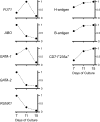Human ABO gene transcriptional regulation
- PMID: 32216153
- PMCID: PMC7187371
- DOI: 10.1111/trf.15760
Human ABO gene transcriptional regulation
Conflict of interest statement
The authors have disclosed no conflicts of interest.
Figures




References
-
- Landsteiner K. Zur Kenntnis der antifermentativen lytischen and agglutinierenden Wirkung des Blutserums and der lymph. Zentralbl Bakteriol 1900;27:357‐63.
-
- Hakomori S. Antigen structure and genetic basis of histo‐blood groups A, B and O. their changes associated with human cancer. Biochim Biophys Acta 1999;1473:247‐66. - PubMed
-
- Yamamoto F. Molecular genetics of ABO. Vox Sang 2000;78:91‐103. - PubMed
-
- Yamamoto F. Cloning and regulation of the ABO genes. Transfus Med 2001;11:281‐94. - PubMed
-
- Yamamoto F, McNeill PD, Hakomori S. Genomic organization of human histo‐blood group ABO genes. Glycobiology 1995;5:51‐8. - PubMed
Publication types
MeSH terms
Substances
LinkOut - more resources
Full Text Sources

